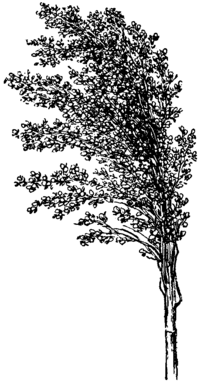 Sorghum vulgare. |
SORGHUM, a genus of grasses belonging to the tribe Andropogoneae, and including one of the most important tropical grains, Sorghum vulgare, great millet, Indian millet or Guinea corn. In India it is known as jawari (Hindustani), jowari (Bengali), cholum (Tamil), and jonna (Telugu), and in the West Indies as Negro or Guinea Corn. It is a strong grass, growing to a height of from 4 to 8 or even 16 ft.; the leaves are sheathing, solitary, and about 2 in. broad and 212 ft. in length; the panicles are contracted and dense, and the grains, which are enclosed in husks and protected by awns, are round, hard, smooth, shining, brownish-red, and somewhat larger than mustard seeds. The plant is cultivated in various parts of India and other countries of Asia, in the United States, and in the south of Europe. Its culms and leaves afford excellent fodder for cattle; and the grain, of which the yield in favourable situations is upwards of a hundredfold, is used for the same purposes as maize, rice, corn and other cereals.
Speaking of its cultivation, Eduard Hackel (in his article on “Grasses” in Die natürlichen Pflanzenfamilien) says the culture of Sorghum probably had its origin in Africa, where a variety known as durra is now cultivated over the entire continent, and has become the most important cereal; the natives also chew the stem, which contains sugar. In Europe it is raised less for bread than for mechanical purposes; the panicles are made into the so-called rice-brooms and into brushes. In Germany it is occasionally raised for green fodder. From the fruit the Kaffirs make an alcoholic drink, Tialva, and the negroes one known as Merisa. Allied species are S. tricolor, much valued in India as a forage-plant, and S. saccharatum, commonly called sorghum or Chinese sugar-cane, which is extensively cultivated in China, North India and Africa. The latter species is grown in America chiefly for the manufacture of molasses from its juice, and in France as a source of alcohol.
A full account of the cultivation and use of the species in India will be found in Sir G. Watt’s Dictionary of the Economic Products of India (1893).